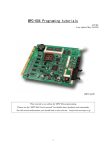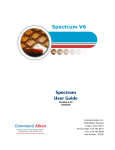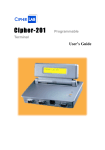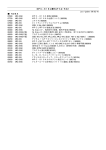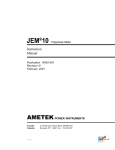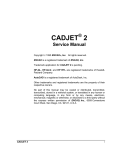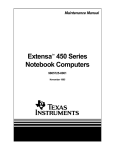Download Accell MPC-68K Series User`s manual
Transcript
Table of Contents MPC-68K System Construction Example ....................................................................... 2 MPC-68K Series ~16-Bit CPU Controller ~ ................................................................. 4 MPC-LNK ............................................................................................................................ 8 MPC-816 Series ~ 8-Bit CPU Controller ~ ................................................................ 10 MPC Peripherals ~ Common for MPC-68K and MPC-816 ~.................................. 14 How to Deal with Noise .................................................................................................. 15 FTMW (FTM – Work Bench) ......................................................................................... 16 List of Compatible Connectors ...................................................................................... 16 Request to Our Customers .............................................................................................. 17 Please Try Controlling by MPC. Your “Device” will Change from That Day. MPC uses the latest flash ROM! Equipped with an on-board ROM-conversion function, it is a board-type controller with complete protection against noise (RS-232C and pulse generation are also photo-isolated). MPC is also equipped with complicated commands and functions. However, multi-axis control is enabled immediately after the power is turned on, as there is simple support by a BASIC-like language. Programming Device Your personal computer such as PC98, DOS/V, etc. can be used as is. The file format is in easilyeditable ASCII data, which is supported by a terminal software “FTM” (its Windows version is also available). Language This is a BASIC-like interpreter. Even a beginner can program immediately. Also, abundant commands make it possible to write complicated applications. Also, although it’s BASIC-like, it’s a full-featured product equipped with multitasking. I/O Control Its dedicated I/O realizes 24~768-point control. Both bit processing and parallel processing are supported by dedicated commands, which allows a wide application. Pulse Generation MPC-816 and MPC-68K can control a stepping/servo motor of up to 50 and 400 kpps, respectively. Instead of simple support for one axis at a time, commands are prepared for even an XY-orthogonal 4-axis robot that includes palletizing. It can also deal with S-shape acceleration/deceleration. Necessary Things for Startup The following are initially necessary to MPC. To be prepared by the customer: A personal computer (PC98DOS, DOS/V, or Windows) DC24V power (necessary for making MPC work) Wiring sockets and contacts, a pressure-attaching tool (JAE product) or PS-50SEN-D4T1-1D, etc. Other necessary connectors depend on products. Please refer to the manual. Connectors ,socket ,and contacts (in the case of individual wires) Control contacts Pressure-attaching tool 030-51304-001(JAE) For socket housing(PS-D4C50) CT150-1-PSSF(JAE) Our Products Cable set (for PC98 and DOS/V compatible machines) FTM terminal software for programming (for PC98, DOS/V machines, and Windows) Main unit (must contain MPC-816 or MPC-68K) Manual (attached at the first purchase) Selection Guideline MPC-816 series are inexpensive and compact for controlling up to 4 axes within 50 kpps and I/O 200 points. MPC-68K can be used for controlling multiple axes within 40 kpps and I/O 500 points. Both of them are equipped with RS-232C for the user. Also, MPC-68K can support complicated character processing by a high-level language. The MPC-816 interpreter (TNYFSC®) is a simple language, and the MPC-68K interpreter (ADVFSC®) is a full-featured BASIC language (computation is limited to 4-byte integers). Also, we have MPC683 for large-scale high-speed processing and floating-point computation. -1- MPC-68K System Construction Example MPC is a BASIC-like multitasking interpreter, which is a FA controller capable of multiple-axis and communication processing as well as I/O of course. [Cable DOS/V 98] RS-232C CH1 Products of ACCEL are inside [ ]. [MPC-68K (FSC)] Main CPU RS-232C 3CH [Terminal software FTM, FTMW32] Programming & teaching personal computer NEC 9801 Toshiba J3100 IBM PC/AT compatible machines Windows 95, NT RS-232C CH2 Touch panel RS-232C CH0 Image processing device 4-axis robot X [MPG-405] 4-axis PG board MAX 400 Kpps Origin port Y X Y U Z Origin SW Encoder Z phase [MPG-405] Y U X XY table Origin SW Encoder Z phase Material removal/supply elevator Z X [MPG-405] X Origin SW [MIP-048] Input dedicated 48 points Maximum 8 boards Encoder Z phase Y Input X [MOP-048] Output dedicated 48 points Maximum 8 boards Output [RACK-68K] 6 slots Maximum 3 boards Connecting possible AC servo motor drivers Mitsubishi MELSERVO-J series, Matsushita MSD series, etc. Difference movement input. Stepping motors Oriental UPD series, etc. Photocoupler input. Device image 4-axis robot + image processing XY table Material removal/supply elevator Transportation conveyer Liquid crystal touch panel, etc. Chip mounter, inserter, assembly adjustment device, etc. * Connecting two slots or more may require a terminator-compatible board MBK-68K. DC 12V ~ DC 24V is supplied to each board of the MPC series, RS-ISO, and PIF-422. For the details of MPC program and hardware, see the “USER’S MANUAL”. Consultation on the MPC construction is available. Feel free to contact us. -2- -3- MPC-68K or MPC-684 MRS-402 MPC-SLINK RS422 68K BUS RS-232 RS485(422) ! SLINK1 * As an option function of MRS-402, WEB, FTP, and TCP/IP are planned to be supported via Ethernet RS converter. Ethernet (TCP/IP) <=> RS Converter SLINK2 ! Display during program execution (7SEG) ! Communication with RS-232 function ! Wiring-saving system, SLINK ! Touch panel support * TCP/IP support (Two 128-point modules loaded) * User customizable MBK-68 Connected with MBK-68 via RS422 at 38.4 kbps. Using the standard ON/OFF command supporting 68K, applications utilizing a touch panel can be constructed ! 98/9 Digital GP70 series supported Touch Panel Display Butaface ! Supported MPC-68K Expandability MPC-68K Series ~16-Bit CPU Controller ~ MPC-684 High-Speed CPU Board 4 Outputs, 8 Inputs [Characteristics] This is a high-speed CPU board equipped with two RS-232C channel. By its installed interpreter (ADVFSC®), programming is possible in a BASIC-like environment. MPC-683 supports an execution speed more than twice as fast as 68K, and floating-point computation. (1) (2) [Specification] Power source: DC 12V~24V battery retained for 5 years (w/o external power supply at room temperature). CPU: MC68340 20M clock. 4M SRAM*2 + 4M FROM*2. Control I/O: 8-point photocoupler input (4-point open collector output). RS232c: 2CH Self-consumed current: 500 mA (1A power source installed) [Option] MC688XXFN-25 Coprocessor (for floating point calculations) [Accessories] MPC-68K (1) Power connector (H4P-SHF-AA) (2) Contacts (BHF-001T-0.8SS) Main CPU Board JST JST *1 *4 4 Outputs, 8 Inputs [Characteristics] This is a CPU board equipped with two RS-232C channels. By its installed interpreter (ADVFSC®), programming is possible in a BASIC-like environment. In spite of its compactness, it is equipped with two 4M-bit flash ROMs, and its program area of about 10000 steps can be used by an actual machine without any procedure such as ROM conversion or compiling. It can also be used as a pulse generator by itself. Its bus is C-bus-based, so an I/O board for 98 can also be directly used. (1) CEP-041 MPC68K (2) ACCEL CORP. [Specification] Power source: DC 12V~24V battery retained for 5 years (w/o external power supply at room temperature). CPU: TMP68301F-16 16 MHz. 1M SRAM*4 + 4M FROM*2. Control I/O: 4-point open collector output. 8-point photocoupler input. RS232c: Photoisolated, user 2CH. Self-consumed current: 250 mA (1A power source installed) [Accessories] MPG-405 (1) Power connector (H4P-SHF-AA) (2) Contacts (BHF-001T-0.8SS) High-Speed S-Shape Acceleration/Deceleration PG Board (400K) (3) (1) (2) JST JST *1 *4 4-Axis Output, 8-Origin Input [Characteristics] This is a dedicated pulse-generation board equipped with the maximum pulse rate of 400 kpps (two-axis linear interpolation). It is an upper-compatible board that can replace MPG68K. Because it uses dedicated pulse generation (except GO, RM, DEFTBL, XPLS, and WPLS), DDA computation, and counter IC, high-speed pulse generation and arc interpolation have become possible. The arc interpolation is up to 200 Kpps. Also, because it is equipped with an S-shape acceleration/deceleration function, vibration prevention of the device is also effective. [Specification] Power source: DC 12V~24V battery retained for 5 years (w/o external power supply at room temperature). CPU: TMP84C015BF, KM3701, X3202, etc. Pulse output: 4-axis/RS422 specification (photoisolated). Consumed current: 180 mA [Accessories] (1) Power connector (H4P-SHF-AA) (2) Contacts (BHF-001T-0.8SS) (3) Connector (HIF-3BA-16D-2.54R) -4- JST *1 JST *4 Hirose *1 MPG-68K PG Board (100K) 4-Axis Output, 8-Origin Input [Characteristics] This is a board equipped with 4-axis simultaneous-control pulse generation. By an interpreter (ADVFSC®) installed on MPC-68K, programming is possible in a BASIC-like environment. The maximum pulse rate is 100 kpps (for 3-axis simultaneous interpolation). One MPC-68K can support about three MPG-68K boards. If a power source unit (MPS-324) is added, about six boards can be supported. (3) (1) (2) [Specification] Power source: DC 12V~24V (for I/O control). Battery retained for 5 years (w/o external power supply at room temperature). Pulse output: 4-axis/RS422 specification (photoisolated). CPU: TMP68301F-16 16MHz. 1M SRAM*2 + 1M PROM*2. Control I/O: 4-axis output, 8-point origin sensor input. Consumed current: 150 mA [Accessories] MOP-048 (1) Power connector (H4P-SHF-AA) (2) Contacts (BHF-001T-0.8SS) (3) Connector (HIF-3BA-16D-2.54R) JST *1 JST *4 Hirose *1 48-Point Transistor Output Board 48 Outputs [Characteristics] This is a dedicated output board equipped with 48-point output. Each output is equipped with an LED monitor. The output interface is an open collector output using a TD62004, where the control current is 100 mA per one output. Therefore, relays and compact solenoids for airpressure control can be connected as they are. Also, because it functions even with 5 V, it can be used as a TTL output interface. Addresses can be specified by DIP switches (full decoding). MPC-68K supports up to eight MOP boards. (1) ACCEL CORP CEP-013B MOP-048 (2) [Specification] Power source: DC 5V~24V (for I/O control). 48-point open collector output. Consumed current: 80 mA [Accessories] MIP-048 (1) Power connector (H4P-SHF-AA) (2) Contacts (BHF-001T-0.8SS) JST JST *1 *4 48-Point Photocoupler Input Board 48 Inputs [Characteristics] This is a dedicated input board equipped with 48-point input. Each input is equipped with an LED monitor. The input interface is a photocoupler input using a TLP-521, where the control current is 2 mA per one input. Also, because it functions even with 5 V if the resistor array is exchanged, it can be used as a TTL input interface. Addresses can be specified by DIP switches (full decoding). MPC-68K supports up to eight MIP boards. MIP-048 is equipped with a resistor socket for two-line sensor compatibility. (1) (2) [Specification] Power source: DC (5V) 12V~24V (for I/O control). 48-point optocoupler input. * If used with DC 5V, the resistor array needs to be replaced. Consumed current: 30 mA [Accessories] (1) Power connector (H4P-SHF-AA) (2) Contacts (BHF-001T-0.8SS) JST JST *1 *4 * Current values indicate standard consumed current TYP values. Please keep 20~50 % room in designing. * Current values indicate consumed current of the internal DC 5V power source, and the maximum current values with all I/Os ON for the I/O boards. * [] Current values indicate externally-supplied DC 24V current, and the minimum current values with all I/Os OFF. -5- IOP-048 24-Point Photocoupler Input Board / 24-Point Transistor Output Board [Characteristics] This is a dedicated input/output board equipped with 24-points for each input and output. Each input/output is equipped with an LED monitor. The input and output interfaces have equivalent specifications with MOP and MIP, respectively. (1) (2) MPG-3202 [Specification] Power source: DC (5V) 12V~24V (for I/O control). 24-point optocoupler input. 24-point open collector output. * If used with DC 5V, the resistor array needs to be replaced. Consumed current: 50 mA [Accessories] (1) Power connector (H4P-SHF-AA) (2) Contacts (BHF-001T-0.8SS) JST JST *1 *4 S-Shape-Compatible PG Board & Encoder Counter Board (2-Axis) [Characteristics] A general-use PG board loaded with pulse generation and counter ICs that can support two axes. Interface of the pulse output and the encoder is RS-422 specification that can deal with high-speed (1M pps) pulse output and input. The mounted PGIC is X3202 that can deal with the S shape and is equipped with various intelligent functions. MPG-3202CEP-075 ACCELCORP. (1) (2) MRS-402 [Specification] Power source: DC 12V~24V Pulse output: Differential pulse output *2 axes / RS-422 specification * 2 axes Encoder input: Differential pulse input (A-B phase encoding) * 2 axes [Accessories] (1) Power connector (H4P-SHF-AA) (2) Contacts (BHF-001T-0.8SS) JST JST *1 *4 RS-232 Expansion Board RS-232C [Characteristics] This is a 2CH RS-232C(RS-485) expansion board, of which up to two can be installed. Because it is an intelligent design by dual-port RAM, it does not provide burden on the CPU. The interface is photo-isolated, and the modem control terminal is RTS×CTS only. Software support is dealt with in a similar way to the standard commands and functions, assigned to #3~#6. (1) MRS-402 CEP-059 ACCEL CORP. MPS-324 (2) [Specification] RS-232 standard interface. Input buffer 1K byte. Consumed current: 50 mA [Accessories] (1) Power connector (H4P-SHF-AA) (2) Contacts (BHF-001T-0.8SS) 3A Power Source Board (3) (1) (2) JST JST *1 *4 4(8)-Point Relay Output [Characteristics] Although MPC-68K is equipped with a 1 A power source, when the system scale becomes large, it becomes short of current. In a large-scale system, this MPS-324 is used. The supplied current is 3 A. Also, MPS-324 is equipped with a 4-point relay output circuit (4 more relays can be further added). A PC98-bus compatible DC ±12 V DC-DC converter can be installed on the board. By this, peripheral boards for 98 requiring ±12 V power source can be used. [Specification] Power source: DC 24V±10%. 4(8)-point relay output. Consumed current: 3 A supply [Accessories] (1) Power connector (H4P-SHF-AA) (2) Contacts (BHF-001T-0.8SS) (3) Connector (HIF-3BA-34D-2.54R) -6- JST *1 JST *4 Hirose *1 MBK-68 Multifunction Board [Characteristics] MBK-68 is a function-addition board of MPC-68K and MPC-683. The following functions are added. Please insert this board to the right end of the rack (on the opposite side of CPU). Bus terminator is added, making a large-scale system more reliable. Display of the statement number during execution is added. 7 SEG display. Digital Corp GP70 Series can be connected. Other supports are under evaluation. Large-scale data arrays can be dealt with by 68K and 683 interpreters. Battery backup function is added to MPC-683. MBK-68K CEP -064A MPC-SLINK RS-422 * 2CH (1) [Specification] Consumed current: 200 mA. Photo-isolated RS422. (2) [Accessories] (1) Power connector (H4P-SHF-AA) (2) Contacts (BHF-001T-0.8SS) Slink I/O Board JST JST *1 *4 MAX 256 * 2 (I/O) [Characteristics] MPC-SLNK is a board which supports the Sanks SLINK system. It is equipped with two host module made by Sanks as a default (maximum 512 points). Also, up to two MPCSLNK boards are supported by 68K. Assigned I/O area starts at 2000. MPC-SLINK CEP-069 ACCEL CORP [Specification] Consumed current: 200 mA (per module). SLINK specification follows that of Sanks. (1) [Accessories] (1) Housing (5557-08R) Molex *2 [Compatible parts] Please purchase upon necessity. Pressure-attaching tool (57027-5000 (Molex)) Extracting tool (57031-6000 (Molex)) Contacts (5556TL (Molex)) Housing (5557-04R (Molex)) RACK-68K6 RACK-68K3 6-Slot Rack 3-Slot Rack [Characteristics] These are board racks dedicated to MPC-68K. Their design is highly condensed with a board pitch of 20 mm. A mounting flange attached as a default is attachable toward any of the top, bottom, front, and back direction. RACK-68K has a 3-slot and a 6-slot version. Also, by a connection kit sold separately, up to three racks can be connected, constructing a system with maximum of 18 slots. The 6-slot rack can be arranged on either the left or the right side, but the 3-slot rack can only be arranged on the right side. Because the bus construction is based on PC98 I/O bus, various kinds of commercial I/ O boards for 98 can be used. [Specification] PC98 I/O bus standard, 20 mm pitch, 6 slots. [Accessories] ADP-68K Screws (M3*4) Screws (M3*12) Rack assembly use For attaching the bus * 16 *4 Connection Kit [Characteristics] This is a connection kit for said racks. By this, RACK-68K can be expanded up to 18 slots. The components are spacers and a 50-pin flat cable. Only the I/O bus signal is connected by the 50-pin flat cable. By this connection kit, racks can be mechanically and electrically (conduction-wise) connected to an arbitrary size, but the reliability will decrease if the bussignal width exceeds 50 cm. [Accessories] Screws (M3*4) Spacers (SP-17) *8 *4 -7- MPC-LNK MPCLNK is a network board with an objective of sharing memory data and bit-unit information. By using MPCLNK, connected equipment (personal computers and MPC-68K) can share 249-byte memory. Also, because a function is included for transferring data by block to a specified address, individual communications that used to be performed by RS-232C etc. are supported together by MPCLNK. The number of connectable units is up to 16. When MPCLNK and LNK-048 are combined, one unit of MPCLNK and up to 15 units of LNK-048 are connectable. The response speed is within 10 msec for transferring a shared variable from #1 to any other, and is the number of connection * 10 msec for changing a shared variable of #2-#15 except #1 or for the input status of LNK-048 to be returned to #1. In the case of up to five-unit connection which is a default factory shipout condition, the response speed is within 50 msec. As for the distance of the communication cable, because it is based on RS-485 standard, the connection will have no problem up to several hundred meters. Also, the communication interface is isolated by a pulse transformer, preventing noise trouble etc. that occurs when used by different power sources. Connection Method J2 J3 J2 SP10 shorted J3 J2 J3 J2 SP10 open SP10 open J3 SP10 shorted Because MPCLNK adopted an interface based on RS-485, it can be easily connected via twisted-pair cables. Two connectors and a short pin for a terminator belong to MPCLNK, and they are connected as in the figure. What should be kept in mind is for the connection to be in a cascade as in the figure and to set the terminator ON (the short pin is shorted) for the MPCLNKs at the ends. PC (AT, 98) + LNK-048 This is a remote IO for a personal computer. One LNK-048 is equipped with 24-point input and 24-point output, and can perform reading of input from the host side and control of the output port. The host needs one MPCLNK, and the I/O unit and MPCLNK are connected via a twisted-pair cable. Because communication is done through an RS-485 interface, connection of plural LNK-048 is simple by multiple-drop bus connections of a twisted pair. Control and reading of the IO are performed via the UMB area of the personal computer (this is because MPCLNK works as a memory installed in the UMB area). Writing into the UMB area is reflected as is by the output port of LNK-048, and the input content of LNK-048 is reflected as is by the specified memory of the UMB. Therefore, the I/O can be directly controlled using application software for DOS/WINDOWS etc. MPC- LNK LNK- 048 E A A O PC- LNK LNK- 048 Twisted pair MPC-68K + LNK-048 LNK-048 CE P -0 4 1 MPC-LNK LNK-048 MPC-68K LNK-048 is a remote IO of MPC-68K. One LNK-048 is equipped with 24point input and 24-point output, and can perform reading of input from the 68K side and control of the output port. The host needs one MPCLNK, and the I/O unit and MPCLNK are connected via a twisted-pair cable. Because communication is done through RS-485 interface, connection of plural LNK048 is simple by multiple-drop bus connections of a twisted pair. For control and reading of IO, the IO commands such as ON/OFF, SW(), etc. of MPC68K are available. Twisted pair LNK-048 + LNK-048 LNK- 048 LNK- 048 By using LNK-048 one on one, the I/O condition can be transmitted as it is to a distant place. The 24-point input content to one is reflected by the output of the other. Connection of LNK-048 is by one twisted pair, withstanding even a distance of several hundred meters (in the case of an RS-485 standard cable). Also, if the IO link destination is fixed, two or more LNK-048 can be IO-connected (customization will be necessary). -8- MPC-LNK, PC-LNK Communication Board MPCLNK CEP-028C ACCEL CORP. (1) (2) (1) (2) [Specification] Communication [Characteristics] MPC-LNK (PC-LNK) is a data network connecting our MPC-68K, NEC PC98 series, and DOS/V machines. Unlike networks by other specifications, it does not let the host generate interruptions or consume system memory. MPC-LNK itself becomes a RAM board connected via communication, both the connected 68K and personal computer having shared variables usable in common. The connection interface uses RS-485 (750 kpps SDLC standard), where a network can be easily constructed by a twisted-pair multiple drop (the maximum connection length is 1.2 km according to the RS-485 specification). MPC-LNK can be utilized not only as a pure 68K network but also as a data exchange network for personal computers using libraries. Shared variables These are common variables of 249 bytes which all MPC-LNK can refer to. Shared variables are refreshed every 24 sec and can be changed or referred to at real time. The content set by the #1 station circulates to the whole every 10 msec, and the content changed by the #2 or latter station is reflected by the whole every n * 10 msec (n is the number of MPC-LNKs connected to the network, whose default value is 5). Also, 68K deals with them as 125 wordtype variables. Mail forwarding All the connected MPC-LNKs can perform block transfers by 250-byte units. In forwarding mail, the receipt status, forwarding, and read-out by the recipient can be confirmed. RS-485/SDLC standard 750 kpps. SN75176B used. Pulse transformer isolated. Shielded twisted pair to be used (60 nF/km) MPCLNK: 68K system bus / PC-98 expansion bus standard (full decoding). PC-LNK: ISA bus. Installed in the UMB area as memory. 68K: 1000H, 2000H fixed (I/O area). PC98 / DOS/V: C0000H~ (expanded ROM area 0~BFFH exclusive). Shared variables 249 bytes Send-mail buffer 250 bytes Receive-mail buffer 250 bytes 150 mA Cable Bus I/F Address Memory Consumed current [Accessories] (98 C-Bus Standard) / PC-LNK (ISA) (1) Power connectors (H4P-SHF-AA) JST (2) Contacts (BHF-001T-0.8SS) JST LNK-048 *2 *6 Remote IO Unit 24-Point Output / 24-Point Input [Characteristics] Remote IO can be used in a MPC-68K system equipped with MPCLNK. LNK-048 is equipped with 24point input and 24-point output, and can monitor the status of a sensor distant from the host or control the actuator. Also, if used as an IO etc. for a control BOX of an apparatus, because the host and LNK048 can be connected via a twisted pair, it will also become a wiring-saving system. Also, it can be used as a remote IO of a personal computer equipped with MPCLNK or PCLNK (PCM95W03, with a case). [Specification] (2) Communication: RS-485/SDLC standard 750 kpps. SN75176B used. Pulse transformer isolated. Cable: Shielded twisted pair to be used (60 nF/km) Power source: DC 24V ± 10% Consumed current: 150 mA (3) (1) [Accessories] (1) Power connector (H4P-SHF-AA) (2) Power connectors (H3P-SHF-AA) (3) Contacts (BHF-001T-0.8SS) JST JST JST *1 *2 *10 * MPC-LNK model will be modified due to production discontinuation of its component ICs within coming years. Although the new series and old series cannot be combined, they can be used in the same software environment. Please take note of this. -9- MPC-816 Series ~ 8-Bit CPU Controller ~ MPC-816K Main CPU Board 8 Outputs, 16 Inputs [Characteristics] This is a CPU board equipped with the I/O for control. By its installed interpreter (TNYFSC), programming is possible in a BASIC-like environment. In spite of its compactness, it is equipped with 2M-bit flash ROM, and its program area of about 2000 steps can be used without any procedure such as ROM conversion or compiling. Also, a user RS-232C (isolated) is equipped, making it applicable to communication-involving use. (3) [Accessories] MPG-916F CEP-080 ACCEL CORP. (1) [Specification] Power source: DC 12V~24V battery-retained for 7 years (w/o external power supply at room temperature). CPU: KL5C80A16, 7.37 MHz, 1M SRAM + 2M FROM. Control I/O: 8-point open collector output, 16-point photocoupler input. Self-consumed current: 110 mA (380 mA power source installed) (2) MIF-816K (1) Housing (PS-D4C50) (2) Power connector (H4P-SHF-AA) (3) Contacts (BHF-001T-0.8SS) JAE JST JST *1 *1 *4 Bus Interface Board 8 Outputs, 16 Inputs [Characteristics] This is the first expansion board of MPC-816. It is a bus interface of expanded I/O: MIO-816 and also equipped with the control I/O at the same time. Also, a 16-pin connector J5 becomes a pulse output port if the Z version is selected on MPC-816, enabling simple control of a pulse motor, etc. Also, MPC-SET (EX) is the set of MPC-816 and MIF-816 being packed in a case. CEP-056 MIF-816K ACCEL CORP [Specification] Power source: DC 12V~24V (for I/O control). Control I/O: 8-point open collector output, 16-point photocoupler input, 4-axis pulse output port. Consumed current: 30 mA (1) [Accessories] (3) (2) (4) (5) MIF-816AD (1) Housing (PS-D4C50) (2) Power connector (H4P-SHF-AA) (3) Contacts (BHF-001T-0.8SS) (4) Connector (HIF-3BA-16D-2.54R) (5) Spacers (MSPLS-7) JAE JST JST Hirose *1 *1 *4 *1 *4 Bus Interface Board with AD/DA 8 Outputs and 12 Inputs CEP-071 MIF-816AD ACCEL CORP 3CH A/D 1CH D/A [Characteristics] This is the first expansion board of MPC-816 and has almost the same specification with MIF-816. Differences from MIF-816 are that it is equipped with a 12-bit A/D and D/A converter and that J5 has no ZCW and ZCCW output. It is best for small-scale analog test output circuits. (2) (1) [Specification] Power source: DC 12V~24V (for I/O control). DC 5V (for A/D and D/A). Internal V can be also used. Control I/O: 8-point open collector output. 12-point photocoupler input. 3-axis pulse port (w/o ZCW and ZCCW). 3-CH analog input.1-CH analog output. Consumed current: 260 mA (150 mA if A/D and D/A are externally supplied.) [Accessories] (3) MBK-816 (1) Power connector (H4P-SHF-AA) (2) Contacts (BHF-001T-0.8SS) (3)Spacers (MSPLS-7) JST JST *1 *4 *4 Touch-Panel Interface Board RS-422(485) 2CH ACCEL CORP. CEP-072A MBK-816 [Characteristics] This is an I/F board for a touch panel display for MPC-816. It is compatible with Memo-Link of Digital Corp. as of March 99, and it can be interfaced with the panel by using only ON/OFF/SW() commands from the MPC-816 side. [Specification] Power source: DC 12V~24V (for panel communication) Control I/O: RS-422(485) 2CH Consumed current: 200 mA [Accessories] (1) (2) (1) Power connector (H4P-SHF-AA) (2)Contacts (BHF-001T-0.8SS) -10- JST JST *1 *4 MPC-816XC Compact Controller 8 Outputs, 16 Inputs [Characteristics] This is a single MPC-816 stored in a case. Please use it when you use one CPU board installed directly in an apparatus. Refer to MPC-816K for the specification details. (1) Housing (PS-D4C50) (2) Power connector (H4P-SHF-AA) (3) Contacts (BHF-001T-0.8SS) JAE JST JST *1 *1 *4 MPC-816XC [Accessories] (1) (3) (2) MPC-SET (EX) Compact Controller 16 Outputs, 32 Inputs [Characteristics] This is a combination of MPC-816 and MIF-816 stored in a case. It can be used also as a controller with 16-point output and 32-point input. Also, because simple pulses can be generated (max 60 Kpps) from J5 of MIF, it can be used also as a positioning device. Refer to MPC-816K and MIF-816K for the specification details. FLASH Slide-in Brain ACCEL MPC-SET(EX) [Accessories] (1) Housing (PS-D4C50) (2) Power connector (H4P-SHF-AA) (3) Contacts (BHF-001T-0.8SS) (4) Connector (HIF-3BA-16D-2.54R) JAE JST JST Hirose *2 *1 *4 *1 (3) (1) (2) (4) MIO-816K Expanded I/O Board 8 Outputs, 16 Inputs [Characteristics] This is an expanded I/O board for MPC. Expansion is possible up to 11 boards. Because all the I/Os are isolated by photocouplers, noise resistivity is high, and each I/O can be used by power sources different from the others. Also, by installing a J2 connector by the user, a small-scale system can be constructed in combination with MPC-816 without using MIF-816. CEP-057 MIO-816K ACCEL CORP [Specification] Power source: DC 12V~24V (for I/O control). Control I/O: 8-point open collector output, 16-point photocoupler input. Consumed current: 50 mA. (1) [Accessories] (3) (2) MIO-248K (1) Housing (PS-D4C50) (2) Power connector (H4P-SHF-AA) (3) Contacts (BHF-001T-0.8SS) JAE JST JST *1 *1 *4 Expanded I/O Board 24 Outputs, 8 Inputs ACCEL CORP. MIO-248K CEP-058B [Characteristics] This is an expanded I/O board for MPC. Expansion is possible up to 11 boards. Because all the I/Os are isolated by photocouplers, noise resistivity is high, and each I/O can be used by power sources different from the others. Also, because it is designed to be compatible with DC 5V, it can also be used as a TTL interface. When used with 5V, a resistor array is added to the SIP socket. [Specification] Power source: DC 5V~24V (for I/O control). Control I/O: 24-point TLP627 photocoupler open collector output,8-point photocoupler input. Consumed current: 110 mA. (1) (2) [Accessories] (3) (1) Housing (PS-D4C50) (2) Power connector (H4P-SHF-AA) (3) Contacts (BHF-001T-0.8SS) -11- JAE JST JST *1 *1 *4 MPG-301 One-Axis Pulse Generation Encoder Counter Board 1M PPS 1-axis pulse output 1M PPS encoder input, etc. [Characteristics] MPG-301 is a pulse-generation multifunction board which is loaded with one Kyopal X3202 and let MPC816 directly operate the IC register. It is capable of flexible control such as changing pulse rate during pulse generation, referring to the present position, S-shape acceleration/deceleration, etc. [Specification] Power source: DC 12V~24V Control I/O: One-axis RS422 driver pulse output. One-axis RS422 encoder input. Z-phase input, limit input, etc. Consumed current:150 mA CEP-070A MPG-301 ACCEL CORP. (2) (1) [Accessories] MPG-303 (1) Power connector (H4P-SHF-AA) (2)Contacts (BHF-001T-0.8SS) JST JST *1 *4 PG Board 2-Axis + 2-Axis Pulse Generation [Characteristics] This is a pulse-generation board based on 2-axis linear interpolation. It is supported by the commands of TNYFSC interpreter installed in MPC-816. Also, MPC-816 supports three MPG-303 boards. In the standard P version, MODE 5 and MODE 6 are used. The maximum pulse rate is 50 kpps. As for the output axis, two axes can be used at an exclusive time from either the XY or ZU axis. [Specification] Power source: DC 5V~24V (for I/O control). Control I/O: 4-axis pulse output port (photo-isolated, open collector). 8-point origin-returning sensor. Maximum pulse rate: 50 kpps CW/CCW2 pulse method. Consumed current: 80 mA (1) (3) (2) MCT-801 [Accessories] (Conserved Item) (1) Connector (HIF-3BA-16D-2.54R) (2) Power connector (H4P-SHF-AA) (3) Contacts (BHF-001T-0.8SS) Hirose *2 JST *1 JST *4 Counter Board [Characteristics] This is a 24-bit up-down counter equipped with an encoder/decoder. It deals with both encoder input and pulse input. The input interface is optoisolated. Although a rotary encoder with 12V power is assumed in the ship-out setting, it can deal with DC 5V and DC 24V by changing the resistor array. Up to two MCT-801s can be used in one system. [Specification] A-B-phase phase encoder input / Up-down pulse input Compatible with 500 kpps. Power source: DC 5V ~ DC 24V Consumed current: 20 mA [Accessories] (1) CARD (Conserved Item) MEMORY MCD-001 (1) (1) Connector (PS-16SEN-D4P1-1) JAE *1 Data Memory Card [Characteristics] This is an interface board for supporting a memory card (32 kbyte) made by Fujisoku. When MCD-001 is used, an array of 10921 is extended as M() on the memory card. By utilizing this numerical data area, switching is performed of the model that used the IC card, storing a large amount of data, etc. Also, MCD-001 is equipped with four digi-switches, enabling a read-out of values by the commands. MPC-816 supports one MCD-001. [Specification] IC card: Made by Fujisoku (BS32D1-A) Consumed current: 10 mA [Accessories] (1) Memory card (BS32D1-A) -12- *1 RACK-SET (A) 4-Board Construction Rack Set [Characteristics] This is a rack set for MPC-816. It deals with a 4-board construction system. MPC-SET (A) is a rack set with MPC-816 and MIF-816 added. [Construction] RACK (A) main body, BUS board A, Rack flange. [Accessories] Screws (M3 * 4) RACK-SET (B) For assembling rack *16 8-Board Construction Rack Set [Characteristics] This is a rack set for MPC-816. It deals with an 8-board construction system. MPC-SET (B) is a rack set with MPC816 and MIF-816 added. [Construction] RACK (B) main body, BUS board B, Rack flange. [Accessories] Screws (M3 * 4) RACK-SET (C) For assembling rack *16 16-Board Construction Rack Set [Characteristics] This is a rack set for MPC-816. It deals with a 16-board construction system. Please be careful about the power source capacity for a 16-board full system. The current-supply capacity of MPC816 is up to 380 mA including 816. If a power shortage is anticipated, please remove JP1 on MPC-816 and supply DC 5V directly to the bus board. MPC-SET (C) is a rack set with MPC-816 and MIF-816 added. [Construction] RACK (C) main body, BUS board A, Rack flange. [Accessories] ADP-325 Screws (M3 * 4) For assembling rack *20 Metal Fittings for Compact Boards [Characteristics] These are metal fittings for compact boards with a PCB width of 70 mm. A commercial I/O board for Z80 can be inserted into the RACK by these. As for the way of attaching it, remove the guide rail, install the metal fittings, and put back the guide rail. [Construction] U-shape metal fittings *2, Fitting machine screws *4. Flange H / Flange D Flange H Flange D Metal Fittings [Characteristics] Metal fittings for MPC-SET (EX) and MPC_816XC. The H type is for a back-face installation, and the D type is for a bottom-face installation. [Construction] Metal fitting *1, Machine screws *2. -13- MPC Peripherals ~ Common for MPC-68K and MPC-816 ~ Cable DOS/V 98 [Characteristics] This is a cable of our company brand to connect MPC and a personal computer. Although the basic cable is for DOS/V, because a 25-pin conversion connector is included, it can also be used for PC98. FTM (FTM98 / FTMDOSV / FTMWIN) [Characteristics] MPC terminal software “FTMW32”, 816/68K command references, Communication program development support tools, etc. are included. [Construction] Setup Disk (3.5” 1.44 MB format). * Other than these, there are FTM versions for NEC98DOS, DOS/V, and English Windows. Please refer to our Business or Technical Department. IOD-024 I/O Relay Box CEP-025 ACCEL [Characteristics] Because the I/O connector of MPC is compact and has high density, wiring work in a large-scale system is troublesome, and because there is no display of the I/O, debugging is laborsome. IOD-024 connects to the I/O connector of MPC via a flat cable, and branches it point by point to a relay connector. Also, because each point is equipped with an LED, wiring debugging and system maintenance become easy. Also, interfacing a sensor containing a two-line amplifier can be done easily. (With a case PCML-95W02) [Specification] Input: 26-pin/50-pin flat cable. Output: Molex 5557-04R + 5556TL [Compatible parts] Please purchase upon necessity. Pressure-attaching tool (57027-5000 (Molex)) Contacts (5556TL (Molex)) Housing (5557-02R (Molex)) PIF-422 PIF-400 Pulse-Signal Conversion Interface (Conversion into RS-422 or TTL) Pulse-Signal Conversion Interface (DC 24V Open Collector) [Characteristics] In MIF-816 and MPC-68K, the pulse-signal output is not isolated. Therefore, if a driver is directly connected, noise may cause the controller to stall. When a high-noise driver such as an AC servo is connected, please use one of the above conversion interfaces depending on the kind of interface. Although PIF-422 is an RS-422 output, if an SG terminal is connected together, it can deal with 5V TTL-level signals. (A case sold separately: PCML-60S02) CEP-027 PIF-422 ACCEL [Specification] Power source: DC 12V~24V Input: TLP-552 Output: SN75158P (for 4 axes) (PIF-422) DC 24V open collector (PIF_400) Consumed current: [70 mA] (PIF-422) [30 mA] (PIF-400) [Accessories] (1) Connector (HIF-3BA-16D-2.54R) (2) Power connector (H4P-SHF-AA) (3) Contacts (BHF-001T-0.8SS) (1) (2) Extracting tool (57031-6000 (Molex)) Housing (5557-04R (Molex)) (3) -14- Hirose JST JST *2 *1 *4 How to Deal with Noise Control involving position determination control internally deals with signals of several msec. Because this signal is at a similar level to a noise signal, no matter what control device is used, reliability and accuracy cannot be obtained without any noise countermeasures. When making a device containing a position-determination control, please keep the following in mind. E A C 200 Electricity leakage breaker Install noise filters to power lines to prevent external-noise: One for strong and another for weak electricity. AC servo is a noise source NF AC servo driver Motor driving line (shielded) No binding with a binding band Encoder line (shielded) Separation Electromagnetic brake Separation Signal line 24V line I/O Pulse Long wiring should be I/O separated by a relay etc. I/O MPC RS-232C RS-232C Pulse I/O RS-232C DC24V PS GND NF MPC power ON/OFF is by the primary side of PS AC200 sequencer noise is significant Sequencer I/O If an MPC I/O and a sequencer I/O of another power source are directly connected, the current comes into MPC. Please separate them with a relay etc. AC100 Stepping motor driver Relay control circuit MS Separate driver lines for a servo motor and stepping motor, signal line, and DC 24V line, and prevent relays as much as possible. Especially for robots and such, please don’t bind motor driver lines, signal lines such as the one for an origin sensor, DC 24V lines, etc. with the same plarail etc. Install surge removers to coil resistors such as solenoid valve, relay, electromagnetic counter, etc. Crosstalk between signal line and lines 5 & 6 by relay of RS-232C for programming via cab-tire cable. Please use twisted-pair cables. RS-232C To be separated from strong Twisted-pair cable should be used for electricity systems and short pulse-signal lines, and should not be wired. Be careful against static cut in the middle or bound with electricity when connecting. strong-electricity systems. One-side grounding It is not good to bind stepping motor driving lines and signal lines such as the one for an origin sensor, either. A surge of AC 200V becomes fatal noise. There are noise countermeasures for electromagnetic switch coils and contacts. Also, these lines and DC 24V system should never be bound together. ON/OFF of induction motor etc. should be preferably done by an SSR with zero cross rather than by a relay. SSR Confirm that the device is grounded. If there is a device which stalls too frequently or produces motor position errors, there must be a clear noise source. The points are the surge based on control by coils and contacts (relay circuit) and driving lines of various large-scale motors. They become fatal noise in 200V systems and a strong noise source even in DC 24V systems. There are plenty of coils that can become a noise source such as coils in conductors, strong AC 200V buzzers, coil noise of solenoid valves, etc. The first things to do in noise troubles are to look for coils and reevaluating power lines. Parts on the Black List Electromagnetically contacting parts: Noise countermeasures to coils and contacts. AC motor: Drive by SSR. Power line wiring. AC/DC solenoid: Noise measure to coils and contacts. 200V and 100V buzzers: Electromagnetic wave measure (distance and shielding). Servo motor: Wiring of power line and signal lines (wire material, length, relay, and binding). -15- FTMW (FTM – Work Bench) FTMW is a programming tool for MPC-816 and MPC-68K, equipped with all the functions necessary for program development and maintenance. <- MPC-816 direct connection. <- MPC-68K direct connection. <- FTM Work Bench ends. <- Dedicated editor starts (programming is possible away from the apparatus). <- MPC system data are updated. Used for version upgrading. <- Various kinds of settings are done. Absolutely necessary for program loading especially in 68k. The dedicated editor is a specialized editor for MPC programming, equipped with reserved word management, simple help with command format, etc. It allows efficient development of MPC programs even off-line. Accel publishes the latest version of the above FTMW and MPC system data on our web side. By this, users can always use MPC equipped with the latest software and latest functions (using the system loader). http://accelmpc.com List of Compatible Connectors 26-Pin I/O Connector Hirose Individual wires Housing HIF3BA-26D-2.54C Contacts HIF3-2226SCA (AWG#22~#26) Pressure welding HIF3BA-26D-2.54R JAE Individual wires Housing PS-D4C16 Contacts 030-51304-001 (AWG#24~#28) Pressure welding PS-16SEN-D4P1-1C (Closed-end type) 16-Pin Connector for Pulse Port JAE Hirose Individual wires Individual wires Housing PS-D4C16 Housing HIF3BA-16D-2.54C Contacts 030-51304-001 (AWG#24~#28) Contacts HIF3-2226SCA (AWG#22~#26) Pressure welding PS-16SEN-D4P1-1C (Closed-end type) Pressure welding HIF3BA-16D-2.54R 10-Pin Connector for RS-232C Port Hirose Individual wires Housing HIF3BA-10D-2.54C Contacts HIF3-2226SCA (AWG#22~#26) Pressure welding HIF3BA-10D-2.54R JAE Individual wires Housing PS-D4C10 (key at one part) Contacts 030-51304-001 (AWG#24~#28) Manual pressure-attaching tool CT150-1-PSSF (AWG#24~#28) Pressure welding PS-10SEN-D4P1-1C (Closed-end type) -16- Request to Our Customers Concerning the application range of our products All of our products use general-use components. Therefore, please refrain from using them for fields requiring high reliability and for the purposes dealing with human life. Product warranty period We maintain or exchange for free our product which broke naturally during normal use only within one year after its shipment. If there is clear maintenance or exchange of a naturally broken product, please send the product to us. On-site service and field costs and expanded damage Our maintenance service is limited to inside our HQ. We will not accept any payment request of a maintenance cost which seems to be caused by on-site maintenance by our employee or our product. If you request for our employee to be sent, we will charge for the maintenance cost set separately. Our products are half products whose specific purpose or usage environment cannot be limited. We cannot compensate for any damage caused by using our product, either. Shipment to a distant place When shipping any device using our product to a distance place such as overseas, a specific procedure regulated by the Trade Administration Order is necessary. Because we have necessary materials for the procedure, please request them when you export our product. Also, because we cannot support the maintenance of any product shipped to a distance place as stated above, please place the responsibility of maintenance upon the user. Reliability of battery backup Although the nominal life of a lithium battery is more than five years, there are very rare instances where the battery life becomes significantly short due to defects of the battery maker or others. Also, retaining data by a battery is not perfect in principle. Although there is an extremely low probability, data can be lost (lightning, photographic strobe, and exposure to radiant rays). Also, there are instances where data are lost due to dew forming during normal transportation, and due to vibrations and extreme humidity occurring during export/ import. When there is worry of program loss or when moving to a distant place where there is no technical staff to perform proper maintenance, please convert the program to a ROM. We cannot be responsible for the program loss. Abolishment of Freon Accompanying the abolishment of Freon, cleaning of our products is gradually shifting to the no-cleaning method. When a board looks like it is not clean, we have been using a non-cleaning type flux. There is no influence on the specification and performance. Because this is a measure from the standpoint of environmental protection, we ask for your understanding. Specification change Since 1996, there has been production discontinuation of 80-system ICs such as 8255 and 8251 one after another. Although we have been changing designs and taking measures each time to keep the compatibility current, part of normally-unused functions etc. may be changed. Please understand this in advance. Flash ROM In November 1996, we adopted flash ROMs. The number of warranted rewriting of a flash ROM is 100,000 times, and the data retaining period is 10 years (same specification as EPROM). Also, because flash ROM may be damaged if the power is cut off while its contents are being erased or rewritten, please use it in a stable power environment during a time of maintenance. * Standards and specifications may be changed without prior announcement. MPC series is our original product. All rights concerning MPC belongs to Accel Corp. ADVFSC, TNYFSC, and MPC-LNK are trademarks of Accel Corporation. MPC-SERIES General Catalog June, 2000 Publisher Publishing house Planning & Editing Revision version 5 Ryuichi Yokota Accel Corporation Tohbu Bldg 5F, 16-32 Nakamachi, Chino City, Nagano 391-0005 TEL 0266 (72) 8465 FAX 0266 (72) 8436 NIFTY-SERVE JDA02023 E-mail: [email protected] http://accelmpc.com Free System -17-


















